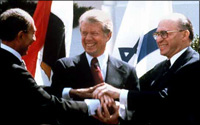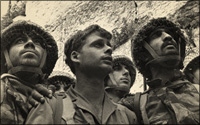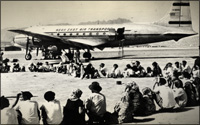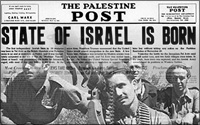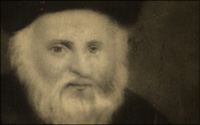 The movement of Chassidus spread rapidly throughout Eastern Europe and it adherents eventually outnumbered the non-Chassidic population of observant Jewry. The Chassidim called non-Chassidim the “Misnagdim,” which means “opponents.” Their strongest and greatest opponent was Rabbi Elijah ben Shlomo Zalman Kremer, otherwise known as the Vilna Gaon or by his Hebrew acronym, the GRA (“Gaon Rabbenu Eliyahu”).
The movement of Chassidus spread rapidly throughout Eastern Europe and it adherents eventually outnumbered the non-Chassidic population of observant Jewry. The Chassidim called non-Chassidim the “Misnagdim,” which means “opponents.” Their strongest and greatest opponent was Rabbi Elijah ben Shlomo Zalman Kremer, otherwise known as the Vilna Gaon or by his Hebrew acronym, the GRA (“Gaon Rabbenu Eliyahu”).
He is the father of many of the coming changes in Jewish life – yet the protector of Jewish tradition. More than anyone else, he did not allow the Chassidim to fall into excesses which would have driven them eventually out of the mainstream of Jewish life.
He was undisputedly a genius among geniuses. As a young child, his fame already spread as a prodigy of note. By the time he was in his early twenties, he was renowned to such an extent that when one says, “the Gaon” (“the great one” or the “incredible genius”) it refers to only one person: the Gaon of Vilna.
The Gaon’s genius began with an incredible photographic memory. It is said that he had “no memory” because everything he ever learned was as fresh as if he had just learned it. From the age of maturity—some say from the age of 20, others say from the age of 30—until at the age of 70 (for at least 40 years of his life), he never slept more than 2 hours out of 24, and he never slept more than 30 minutes consecutively. Combine such diligence with a mind of the ages and it gives us some inkling of what type of person we are talking about.
Lithuania
He was born in 1721 in Vilna, the capital of Lithuania. Among Jews it was known as “Yerushalayim de Lita,” the Jerusalem of Lithuania, because it had always had a reputation for great Torah scholarship — the Gaon was the crown of Vilna. In fact, after the death of the Gaon the city never again took anyone officially in the position of Chief Rabbi. After his death, the leader of the Jewish community was the Dayan, the “Judge.”
One of his first major accomplishments was establishing corrected texts for all the major works of Jewish scholarship. We have since found many of the old, original texts in libraries throughout the world, and we have seen that the Gaon was unerringly correct in changing the extant text at that time to what the real text was.
Rabbi Chaim Volozhin wrote that when the Gaon had to make an emendation in the Talmud he would fast. The easiest thing is to change the text to conform to one’s idea, and many scholars do so. After a while it becomes a charade, and creates the opposite of what scholarship is trying to accomplish. However, the Gaon would fast to enlist Heaven’s support in the change he was about to make in the text.
The Gaon’s range of knowledge was absolutely breathtaking. There was no subject he did not know intimately. Besides the entire corpus of Jewish writings, he knew mathematics, astronomy, science, music, philosophy and linguistics. He did not study the mathematical texts of his day, but from the mathematics of the Torah and the Talmud he deduced mathematical principles and formulas. The Gaon’s interest in all of the sciences was based on his hope to gain Torah knowledge. He said if one did not know mathematics, astronomy, science, etc., then one could not fully appreciate the Torah.
The Gaon was not only well grounded in all fields of revealed knowledge, but he was also the greatest Kabbalist (mystic) of his time — even though he spoke out very strongly against the study of Kabbalah and one of his main objections to Chassidism was its reliance on Kabbalistic ideas.
The Gaon’s interpretations of the Torah and Talmud are absolutely genius. There are a number of books that were written after his death by his disciples and these types of books are still being written today. Some provide his insight on almost every word of the Bible. Others collate some of his famous sayings.
Against Chassidism
The Gaon entered into the fray against Chassidism not on the basis of firsthand observation, but from evidence that was brought to him by others. His main concern was that Chassidus would degenerate into a cult of extremism, magic, miracle workers and all sorts of beliefs that are contrary to Judaism.
He was also afraid that it would further perpetuate the potential for false messiahs. Therefore, he did all in his power to prevent that from happening. That included signing a ban of excommunication against the Chassidim.
A ban from the Gaon was not to be ignored. The Chassidim were constantly forced to defend themselves. Within 35 years after the death of the Gaon, Chassidism became the establishment and the entire bitter dispute had become defused. Nevertheless, in his opposition to Chassidism, he turned the movement away from extremism. He was such a formidable foe they were forced to come to terms with the criticisms that were leveled against them. Once they came to those terms, they were able to reign in the excesses that had emerged.
Father of the Mussar and Yeshiva Movements
The Gaon is viewed as the spiritual father of the Mussar Movement, one of the main great philosophical and social trends of East European Jewry in the 19th century and founded by Rabbi Yisrael Salanter. Put succinctly, the Mussar Movement came to not only restore morality to its highest plane in Jewish life, but to emphasize the development of proper character traits as being the most important thing in life (albeit not at the expense of Torah).
One the movement’s most famous aphorisms was: “If one only has 10 minutes a day to study, what should one study, Mussar or Talmud?” The answer was, “Study mussar, and then you will see that you have more than 10 minutes in the day.” The Mussar Movement, with its emphasis on self-improvement and self-analysis, was almost a psychological reworking of the person. That was a direct inheritance from the Gaon.
The Gaon was also the father of what we would call today the Yeshiva Movement. Beforehand, the “system” was that people learned on their own with a rabbi of their community in the synagogue, and those who showed promise traveled to other great rabbis and continued learning with them. There was no formalized type of higher education.
Formalized higher education began with Rabbi Chaim of Volozhin, and it had been the Gaon’s idea. Until then, a Jewish young man who had a good mind and wanted to study had one address, Torah. He was not accepted in the outside world, and almost none of the outside world seeped into the Jewish world.
During the lifetime of the Gaon, that began to change. There was competition for the Jewish mind now. And in order for Torah to win the competition, it had to use, so to speak, the weapons of the opposition. And that really is the Yeshiva Movement. It was an attempt of the Torah community to formalize its education, to put it in a modern framework, to make it competitive in form—in substance it was always more than competitive—with other types of so disciplines.
Once in a Thousand Years
The Gaon lived in an age of great people – yet he dwarfed them all. Had they lived in any other age, they would have been the leaders of the Jewish people, the leading scholars and intellectuals. As it is, they are great and well-known. Nevertheless, at the time of the Gaon, they were not measured perhaps as they should have been.
One of those great people, Rabbi Israel Lifshitz, author of the commentary Tiferes Yisrael to the Mishnah, wrote: “There is one star that shines in our firmament: the Gaon of Vilna. Once in a thousand years such a person comes into the world. Once only in a thousand years does this falling star come to earth and illuminate the Torah for us in such a fashion.”
In his lifetime, the Gaon wanted to leave Lithuania and travel to the Land of Israel. Legend has it that he set out more than once, but every time he did, something happened that prevented him. He is purported to have said that he saw it as a sign from heaven that they did not want him to go to the Land of Israel.
Nevertheless, his disciples left and made it. The Ashkenazic Jewish community, especially in Jerusalem, was founded by the disciples of the Gaon of Vilna. In Jerusalem today most of the customs in Jewish law and prayer follow those of the Gaon. The influence of the Gaon was therefore enormous on his generation and on all later generations.
He Seals One Era and Begins Another
The Gaon died on the intermediate days of Sukkos 1797 and was buried in Vilna. The Soviet Union, that great peace-loving progressive Socialist state, turned the entire Jewish cemetery in Vilna into a soccer field after the Second World War. Nevertheless, through the efforts of a few Jews a handful of graves were preserved, one of which is that of the Gaon of Vilna. A new tomb and mausoleum has been erected there… right outside the soccer field.
The Vilna Gaon became for the Ashkenazim-Misnagdim what the Baal Shem Tov was for the Chassidim. With him, modern Jewish history in Eastern Europe begins. He seals one era and he begins another era.
This fulfills a pattern we find in Jewish history. Many times the last person of an era is a throwback to the beginning of the era, in terms of greatness. The Gaon of Vilna was a throwback. He was not a man of the 18th century in terms of Torah greatness. He was a man of the 12th or 13th century — 500 years before. His enormous stature, his guiding light, impressed upon Lithuanian Jewry particularly but upon all Eastern European Jewry certain values, educational systems, beliefs, customs, which remain current today.

